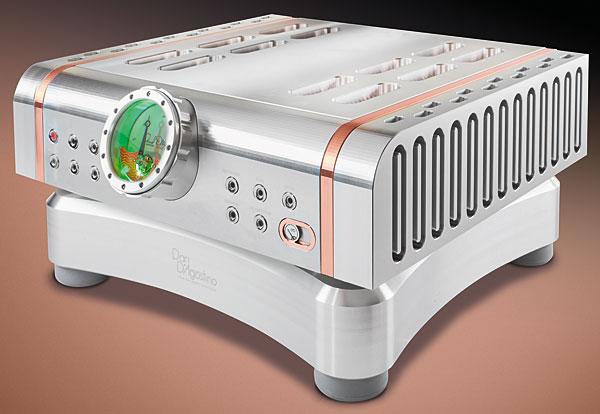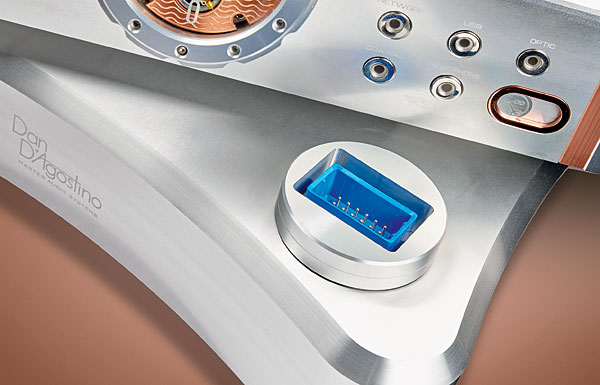D'Agostino MxV Integrated Integrated Amplifier

 This new heavyweight integrated blends inspiration from D'Agostino's Momentum HD preamp and MxV power amp into an app-controlled design with modular upgrade path
This new heavyweight integrated blends inspiration from D'Agostino's Momentum HD preamp and MxV power amp into an app-controlled design with modular upgrade path
Integrated amplifiers are a matter of lifestyle choice, and we've all heard the arguments about why they are either better or worse than separate pre/power combinations. Whatever the sales pitch, pro or anti, the bottom line is that you are choosing space-saving over possible audiophile preferences. With the Momentum MxV Integrated – the other one in the family being the less-costly Progression [HFN Nov '20] – founder and chief engineer Dan D'Agostino is giving you absolutely everything in a single box, for a heady £73,998 in silver or black.
That starting point, however, gets you a line-level-only unit with remote control. Save for one set of RCA inputs, the remainder are balanced, on XLRs. Ironically, despite it being an integrated amp, the Momentum MxV consists of two chassis, but the pair fit together as one. The lower section houses the linear power supplies, fed off a 2000VA transformer, first found in the Momentum M400 MxV amplifier [HFN Nov '22] and said to drive 'a near 60,000µF capacitor bank'. A 30-pin connector on the top mates with a socket on the underside of the preamplifier chassis so rhetoric aside, it's a single unit.

At Your Fingertips
Then you have to add either one or both of two optional modules if you don't already own a high-end DAC or phono stage, and there is nothing it cannot handle should both be fitted, as in the review sample. The DAC (£11,398) enables streaming, network access and accepts any digital source which can be connected via optical, USB, or coaxial connection.
D'Agostino's iOS-only app can access music stored on iPads, iPhones, etc, and the amp has separate aerials for Wi-Fi and Bluetooth, the latter needed for the handheld remote control. The app's screens are self-explanatory, with a directory for music from the Cloud, a local server, or via services on the Internet. This element of the app is less important if you own loads of physical media or have music stored on a server, but as the full use of the Momentum MxV Integrated requires connection to a router – wirelessly or via cable – you might as well make use of the app's features.
What it offers beyond music access are all of the functions found on the hockey-puck-shaped remote, including balance, standby, volume, mute, input selection, polarity inversion and a 'dark mode' to tone down the vivid light show provided by the front panel's buttons and watch face meter.

As for the £5698 phono module, this uses DIP switches for input loading that can be set to 50, 100, 200, 400ohm, 1k or 47kohm. Unfortunately, the DIPs are inside the unit, which requires removing the top cover when you switch between cartridges. Once installed, the phono module takes over the lone pair of RCA inputs, but you can find RCA-to-XLR adapters online for as little as £8 to use the MxV Integrated's balanced inputs with single-ended sources. I confess that the amplifier being XLR-only didn't bother me because I have a phono amp, an open-reel tape deck and a single-box universal CD/SACD/Blu-ray player with balanced outputs. And believe me: it's generally to be preferred.
Recalling the pre-MxV Integrated [HFN Dec '14], and as one who uses a Momentum S250 MxV Stereo Power Amplifier, I was predisposed positively toward the MxV Integrated save for one consideration. The modules beg the question – but ultimately answer it – as to why one chooses an integrated amp over separates, even if they occupy extra space and AC sockets galore. Quite simply, even if you are blessed with both, it's still only about saving space.
The Choice Is Yours
Think about it: fully loaded, this unit leaves little change from £92,000. Adding the modules precludes the need for any extra real estate other than that which the 51kg, 464x241x452mm (whd) lump requires. Only the modules' prices give pause. They are suited to the task, but any audiophile not averse to choosing external components can easily save money and arguably get a better DAC and phono stage.

That, however, defeats the primary raison d'etre of this integrated amplifier, for only the modules offer 100% guaranteed matching of preamp stage, power amp, all inputs and the elimination of interconnects between them. Furthermore, the MxV Integrated's overkill PSU undermines those who argue that separate preamps and power amps benefit from their own isolated power supplies, because this beast of a product treats the power supply as an art form.
In addition to feeding the amplifier music via the app to test that it worked, my findings are based on better-sounding, physical sources: LPs, CDs and reel-to-reel tapes. I'm sure many of you find great joy in streaming services, but I don't.
![]() Tropical Sounds
Tropical Sounds
Faced with a plethora of XLR inputs, I didn't hesitate for a second when it came to firing up my Otari MX5050 reel-to-reel. Of late I have been obsessing over the 'loungecore' music of Martin Denny, who peppered his recordings with exotic sounds. Quiet Village [Liberty 7122] is a prime example, with a slick seven-piece ensemble punctuated by unusual percussion.

























































